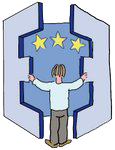Latin at the ESS
Starting in S2, pupils in the three European sections may take classes in Latin and ancient civilisation for 1½ hours a week in S2 and S3. While learning the basics of the inflected language which is Latin, pupils are introduced to the various aspects of day-to-day life in ancient Rome and the historical and political context. With the help of original literary texts, they discover the common semantic roots of European heritage and are encouraged to embark on a rewarding examination of the human adventure in Europe.
This course can be taken for two additional years (S4-S5) for 3 hours a week, which lead to a deeper grammatical and syntactical knowledge of classical Latin and put the emphasis on the variety of literary texts, when works on history, for example, (Caesar, Livy, etc.) or poetry (Virgil, Ovid, etc.) will be discussed. At the end of S5, the written exam (a translation of approximately 50 words) from Kleines Latinum is a harmonised exam used in every European School. It is compulsory and constitutes the grade for Test B in the second semester. Oral exams (translation and questions on a text seen in class) are open to pupils who wish to validate their diploma.
In S6, the objective is to give pupils the wherewithal to grasp the message of a Latin text and its sociocultural and historical context. The programme helps to consolidate linguistic and especially literary knowledge: we discuss history with Sallust and Tacitus, philosophy with Seneca and Cicero, for example, rhetoric with Cicero and Caesar… and poetry with Horace, Virgil and Ovid.
As for the baccalaureate programme, it is a harmonised body of Latin texts on an author or theme (Pensum Europaeum) which is set each year. In the written exam (3 hours), S7 pupils translate a text not seen in class from this author (with dictionary and conspectus grammaticalis) and answer precise questions on an excerpt from the Pensum, worked on in class, in such a way as to interpret the content, structure, historical and sociocultural implications and draw comparisons with other literary, pictorial or architectural works. There is no oral exam.

